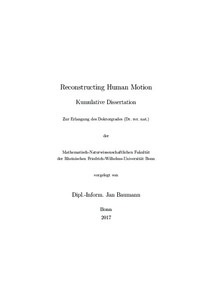Reconstructing Human Motion

Reconstructing Human Motion

| dc.contributor.advisor | Weber, Andreas | |
| dc.contributor.author | Baumann, Jan | |
| dc.date.accessioned | 2020-04-25T02:15:54Z | |
| dc.date.available | 2020-04-25T02:15:54Z | |
| dc.date.issued | 22.05.2018 | |
| dc.identifier.uri | https://hdl.handle.net/20.500.11811/7555 | |
| dc.description.abstract | This thesis presents methods for reconstructing human motion in a variety of applications and begins with an introduction to the general motion capture hardware and processing pipeline. Then, a data-driven method for the completion of corrupted marker-based motion capture data is presented. The approach is especially suitable for challenging cases, e.g., if complete marker sets of multiple body parts are missing over a long period of time. Using a large motion capture database and without the need for extensive preprocessing the method is able to fix missing markers across different actors and motion styles. The approach can be used for incrementally increasing prior-databases, as the underlying search technique for similar motions scales well to huge databases. The resulting clean motion database could then be used in the next application: a generic data-driven method for recognizing human full body actions from live motion capture data originating from various sources. The method queries an annotated motion capture database for similar motion segments, able to handle temporal deviations from the original motion. The approach is online-capable, works in realtime, requires virtually no preprocessing and is shown to work with a variety of feature sets extracted from input data including positional data, sparse accelerometer signals, skeletons extracted from depth sensors and even video data. Evaluation is done by comparing against a frame-based Support Vector Machine approach on a freely available motion database as well as a database containing Judo referee signal motions. In the last part, a method to indirectly reconstruct the effects of the human heart's pumping motion from video data of the face is applied in the context of epileptic seizures. These episodes usually feature interesting heart rate patterns like a significant increase at seizure start as well as seizure-type dependent drop-offs near the end. The pulse detection method is evaluated for applicability regarding seizure detection in a multitude of scenarios, ranging from videos recorded in a controlled clinical environment to patient supplied videos of seizures filmed with smartphones. | en |
| dc.language.iso | eng | |
| dc.rights | In Copyright | |
| dc.rights.uri | http://rightsstatements.org/vocab/InC/1.0/ | |
| dc.subject | Bewegungserkennung | |
| dc.subject | Bewegungsrekonstruktion | |
| dc.subject | Epilepsie | |
| dc.subject | Anfallsdetektion | |
| dc.subject | action recognition | |
| dc.subject | video pulse detection | |
| dc.subject | motion capture | |
| dc.subject | epilepsy | |
| dc.subject | seizure detection | |
| dc.subject | motion reconstruction | |
| dc.subject.ddc | 004 Informatik | |
| dc.title | Reconstructing Human Motion | |
| dc.type | Dissertation oder Habilitation | |
| dc.publisher.name | Universitäts- und Landesbibliothek Bonn | |
| dc.publisher.location | Bonn | |
| dc.rights.accessRights | openAccess | |
| dc.identifier.urn | https://nbn-resolving.org/urn:nbn:de:hbz:5n-50556 | |
| ulbbn.pubtype | Erstveröffentlichung | |
| ulbbn.birthname | Pawliska | |
| ulbbnediss.affiliation.name | Rheinische Friedrich-Wilhelms-Universität Bonn | |
| ulbbnediss.affiliation.location | Bonn | |
| ulbbnediss.thesis.level | Dissertation | |
| ulbbnediss.dissID | 5055 | |
| ulbbnediss.date.accepted | 05.12.2017 | |
| ulbbnediss.institute | Mathematisch-Naturwissenschaftliche Fakultät : Fachgruppe Informatik / Institut für Informatik | |
| ulbbnediss.fakultaet | Mathematisch-Naturwissenschaftliche Fakultät | |
| dc.contributor.coReferee | Eberhardt, Bernd |
Dateien zu dieser Ressource
Das Dokument erscheint in:
-
E-Dissertationen (4379)




